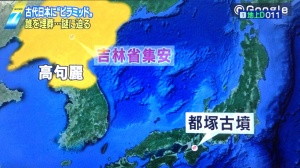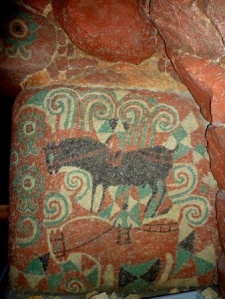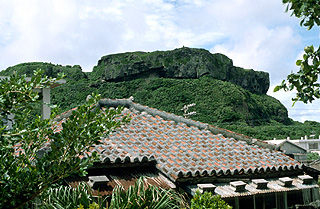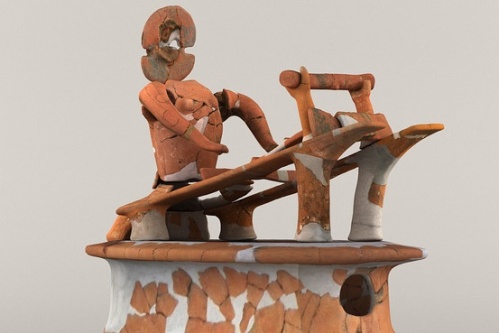
The Raifuku (outer robe) of the ceremonial court costume of the Emperor Komei(r. 1846-1866). This ceremonial court costume originates in the Nara-period (710-784) Imperial Collections of Japan Source: Japanese Symbols of Government
From a previous post “Ainu cloud motif and their creation myth of deity’s descent on five-colored cloud“, we traced the use of the cloud motif and symbolism in conjunction with deities or divinities, ancestors, sages and heroes to their early use both in art and in concepts in genealogies and myths of the peoples of the Northeast Eurasia or Far East.
From Eccentric Spaces, Hidden Histories: Narrative, Ritual, and Royal Authority” by David T. Bialock, comes an understanding of the origin of the “chinkon” and tama “cloudsoul” concept and the rites, and the purpose behind it and the cosmological framework that surrounded it:
Although Nihon shoki’s entry on Temmu’s rite is regarded as the earliest extant mention of the chinkon (spirit pacification), the graphs glossed as “mitama-furi” in the text are actually shokon, also read tama-yobai (“soul-summoning”). The conventional chinkon reading of the passage together with its vernacular gloss “mitama-furi” probably dates from a commentarial tradition transmitted by the Urabe lineage. Thus, according to a secret kun-reading given in the twenty-first scroll of the Shaku nihongi, the graphs were intended to be read “mitama-furi,” a ritual elsewhere represented in Shaku nihongi by the graphs chinkonsai. This eading of the graphs, now well established, was also argued for by Ban Nobutomo in his classic study Chinkon den, where he noted that the phrase “should be recorded as , but one can surmise that it was written in conformance with the usual Chinese practice.”51
… turn to some descriptions of the chinkon rite in the law codes and their commentaries, which have been the basis for most attempts to construct its ancient ritual function. These include the Taiho Code o 701 (extant only fragmentarily in the later Yoro Code), the Ryo no shuge (selected in 833), and the Ryo no guge (selected prior to 868). According to the Taiho Code , the chinkonsai was held in midwinter in the Eleventh Month on a tora no hi (days of the tiger), and followed by the daijosai on a u no hi (day of the rabbit), a period that coincided with the winter solstice. In Chinese yin-yang five agents thought, both of these days were identified with the agent wood (the beginning of the cycle), which corresponded to the direction east and the season spring. Both the month and days were a time when the positive yang pneumas were believed to mount upward and all things were held to be in a state of movement. It was thus an ideal time for initiating activities such as royal accessions. 52
turning to some actual definitions of the chinkon rite, we find the following explanation in the Ryo no gige under the heading chinkon: “The graph means to pacify. A person’s yang spirit (yoki) is called soul (tama). The tama moves about, meaning one summons back the tama that wanders about in a state of separation and pacifies it inside the body (literally “bowels”.] Therefore it is named “chinkon” (to pacify the soul), another definition from the Ryo no shuge contains some additional details: A person’s yang spirit is called ‘kon’ it moves about. A person’s yin spirit is called ‘haku’ it is white. Therefore one calls back the white soul wandering about in a state of separation and causes it to be pacified inside the bowels. Therefore it is called chinkon.
The exact source for the ideas contained in these descriptions remains uncertain, but the language recalls ancient Chinese ideas about the fate of the soul after death. According to the Li ji: the yang qi of the “cloudsoul” (hun) rises up to the sky (tian) after death, whereas the yin or dark elements associated with the body or “whitesoul” (po) return to the earth. 55 Another passage in the Li Ji , on the rites of mourning , speaks of summoning back the cloudsoul and returning it to the body (po)56. It was under the influence of such commentaries, according to Watanabe Katsuyoshi, that modern scholars developed the idea of a “soul that wanders about in separation from its body” and interpreted chinkon as a rite primarily aimed at preventing such separation by placating the “tama” and thereby obviating the illness and death that were held to result from such separation57.
The yin-yang five agents principles and the related concept of “qi” which informed the ritual setting (temporal and geomantic) of the chinkonsai and the descriptive language of the law doctors, were fundamental, of course to Chinese philosophical thought. In Daoism, the induction of qi into the body and its proper regulation became one of the basic practices for achieving longevity, a central concern of later Daoist literature, as in Xiang’er’s commentary on the Daodejing, which also functioned as a guide to the enlightened ruler.58 thus in Bokenkamp’s paraphrase of one Xiang’er passage “the pneumas of morning and evening should be caused to descend into the human body , where they should be mixed with the body’s own pneumas so that they are evenly distributed throughout.” On the other hand, this time citing directly from the Xiang’er “When the heart produced ill-omened and evil conduct, the Dao departs, leaving the sack (belly) empty. Once it is empty, deviance enters, killing the person.”60 As these citations make clear, the principle of balancing and harmonizing qu was of paramount importance; deviance” (xie) on the other hand, arose from a failure to achieve a proper balance or mixing o pneumas resulting in illness and death. … The emphasis in the Xiang’er passage on the belly, for example, recalls what Watanabe characterizes as the peculiar language of the law commentaries where the aim of the rite was to draw the erring “tama” back into the “bowel“. A related notion found in the Chuxue ji, a Tang period encyclopedia compiled at the order of Emperor Xuangzong (r. 712-756), states that on the winter solstice the yang qi is restored to the belly and hot things placed in qi are easily digested.61 If this Daoist medical advice offers a parallel to the ideas of the law doctors in their attempts to describe the chinkon rite, recipes for the production of immortality elixirs provide a suggestive context for understanding the relationship between the medicinal herb and Temmu’s spirit-summoning rite. An entry from scroll seventy-seven on “elixirs” in Yunqi qiqian (Seven Lots from the Satchel of the Clouds), an encyclopedia of older Daoist texts and extracts compiled under the Northern Song, describes a life-extending elixir called lingwan that allows one to “pacify the cloud souls, coagulate the white souls, and fly off into the seventy-four directions,” and in another passage “to sport about on the Five Mountain Peaks.” Not least interesting here is the combination of graphs chinkon, “pacify the cloud souls”) the same two graphs that are used for the Japanese chinkon or “mitama-furi” rite. Another entry from the Inner Transmission of the Purple Sun Master (Ziyang zhenren neichuan, 399), collected in scroll 106 of the Yunji qiqian, relates that the consumption of zhu over a period of five years–the same medicinal herb ingested by Temmu–produces a glow in the body, gives one a vision that can see right through to the five viscera, and enables one to become an immortal.
By now it should be evident that Temmu’s ingestion of the herb hakuchi cannot be fully accounted for by a straitforward medical reading. The calendrical and yin-yang principles that informed its consumption and the accompanying shokon rite belonged to the same sphere of symbolic activity that would soon be housed in the Yin-Yang bureau and Medical bureau and as the following notice from Jito’s chronicle makes clear: “The Yin-yang Doctors, the priest (shoshi) Hozo and Doki, received twenty of ryo of silver.”64 The date of this third reference to Hozo, just prior to the establishment of the official Yin-Yang Bureau, indicates that he was one of than important group of technical experts who mediated the cultural assemblage transmitted from the continent. Although the ingestion of the herb zhu (hakuchi) and its efficacy as both a medicinal and immortality elixir are well documented in Daoist lore and herbals the practice seems to have especially flourished in the period of the Southern dynasties (420-589) when Tao Hongjing composed his herbal and Daoist works.65 It can be assumed that Hozo, a Paekche immigrant would have been knowledgeable about this tradition–its influence having reached the Korean kingdom–as well as conversant with practices from Tao honjing’s region that were outside the written transmission.66 In the early Tang work Qianjinyaogang (Essential Prescriptions Worth a hundred Weight in Gold), composed by the Daoist master and physician Sun Simiao (d. 682) sometimes between 650 and 658. Predating the Tang medical reforms , this text transmitted a tradition very close to the earlier Southern dynasties ‘ tradition and contained detailed discussions on the preparation of zhu and its capacity to harmonize in accord with yin-yang five agents principles.67
The cosmological theory of resonance, much of which is recorded in the Gogyo taigi that reached Japan no later than the end of the seventh century invests Temmu’s ingestion of the elixir and the shokon rite with its reliopolitical significance. Held in the Eleventh Month on a a tora no hi (day of the tiger), the rite’s timing corresponded to the agent wood and the direction east. In Daoist medical lore pertaining to the five viscera, the cloudsoul (kon) resided in the liver (kan), which was identified with the element wood and controlled the eyes, hair, nail, and muscles. The liver was also known as the Office of the General, the faculty responsible for wise counsel; and its element wood was identified with “virtue” (jin) that actifies the myriad things making its analogous to the ruler.68 According to another text cited in Gogyo taigi, The lineage of Thearchs (DIXI pu), “Heaven and earth first arose, then generated the Heavenly Thearch (tenno) who rules through the virtue wood,” a formulation that derives from the symbolism of the hexagram zhen, identified variously with lightning, the dragon and the dark springs. The Yijing states that the thearch and myriad things arise from zhen, with zhen identified with the direction east.69 Although these correspondences add weight to the medical aim of this hybrid rite, they do so by locating Temmu at the center of a radiating cosmological order, which gains additional significance because the rite took place at a critical juncture when the tenno was being newly adopted as a title of authority.70
The belief of musubi – binding the soul to keep it from wandering off (see also The symbolism of knots, and Frazer on the separable external soul)
During the Chinkonsai,
“The chief officiant counts eight times from one to ten, knotting the yufu each time. By tying knots in this symbol of the emperor’s life span, the officiant keeps his tama from slipping away. the eight times and eight knots refer to the eight musubi (binding) tama of deities.
As one can see by these examples, the mitamashizume or chinkon-sai was a ritual means to fix the emperor’s tama so that it would not leave his body. the ancient Japanese greatly feared wandering tama and made the utmost efforts to affix them. A similar ceremony is still being carried out secretly each year at the Isonokami shrine (Renri City, Nara prefecture). This ritual may have to do partly with the Kyujiki, a text which gives much more importance to the Mononobe clan whose ancestral deity is enshrined at Isonokami, than the Kojiki and Nihon Shoki.
Such tamafuri and tamashizume rituals were often popularly called iki-bon, the Bon of living spirits. the Buddhist Urabon festival of late summer, however, a festival primarily concerned with the souls of the dead, has now superseded in importance this ceremony for the souls of the living.”
Source: Rethinking Japan Vol 1.: Literature, Visual Arts & Linguistics (by Adriana Boscaro, Franco Gatti, Massimo Raveri)
The Taoist concept of soul summoning may have been transmitted via Korean immigrants, or directly by Chinese immigrants, or both.

A celestial being on a cloud motif seen on an ancient bronze bell of the Korean kingdom Silla. c. 833 Photo source: Imperial Japanese Commission to the Panama-Pacific International Exposition: Japanese Temples and their Treasures (The Shimbi Shoin 1915) Wikimedia Commons
Chinkon rituals of “shaking the soul”
From Ze’ev Erlich’s Torifune and tama furi:
TAMA FURI/ Furitama-no-Gyo
Tama(soul) Furi (shake) basic meaning is the self Chin-kon and relates directly to the furube-no-kamu-waza of Chinkon Saho.
Furitama ( Soul Shaking)
1. Stand with your legs apart about shoulder width .
2. Place your hands together with the right hand over the left. Leave space between them big enough for an imaginary ping pong ball.
3. Place your hands in that position in front of your stomach and 0shake them vigorously up and down.
4. While shaking them concentrate and repeat the words: Harae-do-no-Okami – an invocation to the kami of the place of harai.
The Object Furitama-no-gyo
The purpose of shaking the soul is to generate awareness of it within yourself. Kon, (the soul), in Shinto, is one of the four important elements along with Mei (life), Rei (spirit) and Ki (which means Spirit in its causal aspect – Ki is a kind of energy source). Kon is the most important of the four since human beings can also be described as Waketama (separated individual souls), which is another way of saying “children of the kami”.
…
In Chinese art, an ancient cloud “meander” motif is related to the Hun and Po concepts of the afterlife. The cloud is a commonly seen design and when repeated in a pattern symbolizes never-ending fortune.
Clouds, sometimes referred to as “auspicious clouds” (xiangyun 祥云), represent the heavens and also “good luck” because the Chinese word for cloud (yun 云) is pronounced the same as yun (运) meaning “luck” or “fortune”. Auspicious clouds may be seen on coins and charms or amulets.
The cloud motif or form often resembles the auspicious shape of the lingzhi “fungus of immortality”. These are concepts that are related to thunder and the ability to call down rain, and also closely related to dragon and star symbolism. (Source: The Hidden or Implied Meaning of Chinese Charm Symbols)
Theories on the Taoist concepts of Hun and Po souls
Chinese Taoist or daoist texts
Hun controls yang spirits in the body,
Po controls yin spirits in the body,
all are made of qi.
Hun is responsible for all formless consciousness,
including the three treasures: jing, qi and shen.
Po is responsible for all tangible consciousness,
including the seven apertures: two eyes, two ears, two nose holes, mouth.
Therefore, we call them 3-Hun and 7-Po.
Master Hu continues with an elaboration of these dynamics; and ends by pointing out that, like all of cyclic existence, the relationship between Hun and Po is a seemingly “endless cycle,” which is transcended “only by the achieved,” i.e. by the Immortals (in their transcendence of all duality):
He Yin-Yang’s Framework For Understanding Hun & Po
Another way of understanding Hun and Po is as an expression of Yin and Yang. As Twicken points out, the Yin-Yang framework is the foundational model of Chinese metaphysics. In other words: it is in understanding how Yin and Yang relate to one another (as mutually-arising and inter-dependent) that we can understand how — from a Taoist perspective — all pairs of opposites “dance” together, as not-two and not-one: appearing without actually “existing” as permanent, fixed “entities.”
In this way of viewing things, Po is associated with Yin. It is the more dense or physical of the two “spirits,” and is known also as the “corporeal soul,” since it returns to earth — dissolving into gross elements — at time of the time of the death of the body.
Hun, on the other hand, is associated with Yang, since it is the more light or subtle of the two “spirits.” It’s known also as the “ethereal soul,” and at the time of death leaves body to merge into more subtle realms of existence.
In the process of Taoist cultivation, the practitioner seeks to harmonize the Hun and Po, in a way which gradually allows the Po (the more dense) aspects to more and more fully support the Hun (the more subtle) aspects. The outcome of this kind of refinement process is the manifestation of a way-of-being and way-of-perceiving known by Taoist practitioners as “Heaven on Earth.”
Staying & Moving In The Mahamudra Tradition
In the Tibetan Mahamudra tradition (associated primarily with the Kagyu lineage), a distinction is drawn between the “staying” and the “moving” aspects of mind.
The “staying” aspect of mind refers more-or-less to what is sometimes also called the “witnessing” capacity. It is the perspective from which the arising and dissolving of various phenomena (thoughts, sensations, perceptions) is observed. It is the aspect of mind which has the capacity to remain (and is quite naturally) “continuously present,” and unaffected by the “objects” or “events” that arise within it.
The “moving” aspect of mind refers to the various appearances which — like waves on an ocean — arise and dissolve. These are the “objects” and “events” that seem (at least initially) to have a space/time duration: an arising, an abiding, and a dissolution. As such, they seem to undergo change or transformation — in opposition to the “staying” aspect of mind, which is unchanging.
A Mahamudra practitioner trains, first, in the capacity to toggle back and forth between these two (“staying” and “moving”) perspectives (known also as the “mind-perspective” and the “event-perspective”). And then, eventually, to experience them as simultaneously-arising and indistinguishable (i.e. nondual) — in the way that waves and ocean, as water, actually are mutually-arising and indistinguishable.
Taoism Meets Mahamudra, For A Cup Of Tea
The resolution of the moving/staying polarity, I would suggest, is basically equivalent (or at least opens the way for) the transcending of what Master Hu refers to as the tangible-consciousness/formless-consciousness polarity; and the absorption of the more densely-vibrating Po into the more subtle Hun.
Or, to put it another way: the corporeal Po “serves” the ethereal Hun — in Taoist cultivation — to the extent that mind’s appearances become self-aware, i.e. conscious of their source & destination in/as the Hun — like waves becoming conscious of their essential nature as water.
Source: Hun and Po
Hun (Chinese: 魂; pinyin: hún; Wade–Giles: hun; literally: “cloud-soul”) and po (Chinese: 魄; pinyin: pò; Wade–Giles: p’o; literally: “white-soul”) are types of souls in Chinese philosophy and traditional religion. Within this ancient soul dualism tradition, every living human has both a hunspiritual, ethereal, yang soul which leaves the body after death, and also a po corporeal, substantive, yin soul which remains with the corpse of the deceased. Some controversy exists over the number of souls in a person; for instance, one of the traditions within Daoism proposes a soul structure of sanhunqipo 三魂七魄; that is, “three hun and seven po“. The historian Yü Ying-shih describes hun and po as “two pivotal concepts that have been, and remain today, the key to understanding Chinese views of the human soul and the afterlife.”[1]
The Chinese characters 魂 and 魄 for hun and po typify the most common character classification of “radical-phonetic” or “phono-semantic” graphs, which combine a “radical” or “signific” (recurring graphic elements that roughly provide semanticinformation) with a “phonetic” (suggesting ancient pronunciation). Hun 魂 (or 䰟) and po 魄 have the “ghost radical” gui 鬼 “ghost; devil” and phonetics of yun 云 “cloud; cloudy” and bai 白 “white; clear; pure”.
Besides the common meaning of “a soul”, po 魄 was a variant Chinese character for po 霸 “a lunar phase” and po 粕 “dregs”. The Shujing “Book of History” used po 魄 as a graphic variant for po 霸 “dark aspect of the moon” – this character usually means ba 霸 “overlord; hegemon”. For example, “On the third month, when (the growth phase, 生魄) of the moon began to wane, the duke of Chow [i.e., Duke of Zhou] commenced the foundations, and proceeded to build the new great city of Lǒ” (tr. Legge 1865:434). The Zhuangzi “[Writings of] Master Zhuang” wrote zaopo 糟粕 (lit. “rotten dregs”) “worthless; unwanted; waste matter” with a po 魄 variant. A wheelwright sees Duke Huan of Qi with books by dead sages and says, “what you are reading there is nothing but the [糟魄] chaff and dregs of the men of old!” (tr. Watson 1968:152).
In the history of Chinese writing, characters for po 魄/霸 “lunar brightness” appeared before those for hun 魂 “soul; spirit”. The spiritual hun 魂 and po 魄 “dual souls” are first recorded in Warring States period (475–221 BCE) Seal Script characters. The lunar po 魄 or 霸 “moon’s brightness” appears in both Zhou Dynasty (1045–256 BCE) Bronzeware script and Oracle bone script, but not in Shang Dynasty (ca. 1600–1046 BCE) oracle inscriptions. The earliest form of this “lunar brightness” character was found on a (ca. 11th century BCE) Zhou oracle bone inscription (Yü 1987:370).
Etymologies
The po soul’s etymology is better understood than the hun soul’s. Schuessler (2007:290, 417) reconstructs hun 魂 “‘spiritual soul’ which makes a human personality” and po 魄 “vegetative or animal soul … which accounts for growth and physiological functions” as Middle Chinese γuən and pʰak from Old Chinese *wûn and *phrâk.
The (ca. 80 CE) Baihu Tang 白虎堂 gave pseudo-etymologies for hun and po through Chinese character puns. It explains hun 魂 with zhuan 傳 “deliver; pass on; impart; spread” and yun 芸 “rue (used to keep insects out of books); to weed”, and po 魄 withpo 迫 ” compel; force; coerce; urgent” and bai 白 “white; bright”.
What do the words hun and [po] mean? Hun expresses the idea of continuous propagation ([zhuan] 傳), unresting flight; it is the qi of the Lesser Yang, working in man in an external direction, and it governs the nature (or the instincts, [xing] 性). [Po] expresses the idea of a continuous pressing urge ([po] 迫) on man; it is the [qi] of the Lesser Yin, and works in him, governing the emotions ([qing] 情). Hun is connected with the idea of weeding ([yun] 芸), for with the instincts the evil weeds (in man’s nature) are removed. [Po] is connected with the idea of brightening ([bai] 白), for with the emotions the interior (of the personality) is governed. (tr. Needham and Lu 1974:87)
Etymologically, Schuessler says pò 魄 “animal soul” “is the same word as” pò 霸 “a lunar phase“. He cites the Zuozhuan (534 BCE, see below) using the lunar jishengpo 既生魄 to mean “With the first development of a fetus grows the vegetative soul”.
Pò, the soul responsible for growth, is the same as pò the waxing and waning of the moon”. The meaning ‘soul’ has probably been transferred from the moon since men must have been aware of lunar phases long before they had developed theories on the soul. This is supported by the etymology ‘bright’, and by the inverted word order which can only have originated with meteorological expressions … The association with the moon explains perhaps why the pò soul is classified as Yin … in spite of the etymology ‘bright’ (which should be Yang), hun’s Yang classificiation may be due to the association with clouds and by extension sky, even though the word invokes ‘dark’. ‘Soul’ and ‘moon’ are related in other cultures, by cognation or convergence, as in Tibeto-Burman and Proto-Lolo–Burmese *s/ʼ-la “moon; soul; spirit”, Written Tibetan cognates bla “soul” and zla “moon”, and Proto-Miao–Yao *bla “spirit; soul; moon”. (2007:417)
Lunar associations of po are evident in the Classical Chinese terms chanpo 蟾魄 “the moon” (with “toad; toad in the moon; moon”) and haopo 皓魄 “moon; moonlight” (with “white; bright; luminous”).
The semantics of po 魄 “white soul” probably originated with 霸 “lunar whiteness”. Zhou bronze inscriptions commonly recorded lunar phases with the terms jishengpo 既生魄 “after the brightness has grown” and jisipo 既死魄 “after the brightness has died”, which Schuessler explains as “second quarter of the lunar month” and “last quarter of the lunar month”. Chinese scholars have variously interpreted these two terms as lunar quarters or fixed days, and (Shaughnessy 1992:136–145) Wang Guowei‘s lunar-quarter analysis the most likely. Thus, jishengpo is from the 7th/8th to the 14th/15th days of the lunar month and jisipo is from the 23rd/24th to the end of the month. Yü (1987:370) translates them as “after the birth of the crescent” and “after the death of the crescent”. Etymologically, lunar and spiritual po <pʰak < *phrâk 魄 are cognate with bai < bɐk < *brâk 白 “white” (Matisoff 1980, Yü 1981, Carr 1985). According to Hu Shih (1946:30), po etymologically means “white, whiteness, and bright light”; “The primitive Chinese seem to have regarded the changing phases of the moon as periodic birth and death of its [po], its ‘white light’ or soul.” Yü (1981:83) says this ancient association between the po soul and the “growing light of the new moon is of tremendous importance to our understanding of certain myths related to the seventh day of the months.” Two celebrated examples in Chinese mythology are Xi Wangmu and Emperor Wu meeting on the seventh day of the first lunar month and The Princess and the Cowherd or Qixi Festival held on the seventh day of the seventh lunar month.
The etymology of hun < γuən < *wûn 魂 is comparatively less certain. Hu (1946:31) said, “The word hun is etymologically the same as the word yun, meaning “clouds.” The clouds float about and seem more free and more active than the cold, white-lighted portion of the growing and waning moon.” Schuessler cites two possibilities.
Since pò is the ‘bright’ soul, hún is the ‘dark’ soul and therefore cognate to yún 雲 ‘cloud’ [Carr 1985:62], perhaps in the sense of ‘shadowy’ because some believe that the hún soul will live after death in a world of shadows [Eberhard 1967:17]. (2007:290)
Both Chinese hun and po are translatable as English “soul” or “spirit“, and both are basic components in “soul” compounds. In the following examples, all Chinese-English translation equivalents are from DeFrancis (2003).
- hunpo 魂魄 “soul; psyche”
- linghun 靈魂 “soul; spirit”
- hunling 魂靈 “(colloquial) soul; ghost”
- yinhun 陰魂 “soul; spirit; apparition”
- sanhunqipo 三魂七魄 “soul; three finer spirits and several baser instincts that motivate a human being”
- xinpo 心魄 “soul”
Hunpo and linghun are the most frequently used among these “soul” words.
Joseph Needham and Lu Gwei-djen, eminent historians of science and technology in China, (1974:88) define hun and po in modern terms. “Peering as far as one can into these ancient psycho-physiological ideas, one gains the impression that the distinction was something like that between what we would call motor and sensory activity on the one hand, and also voluntary as against vegetative processes on the other.”
Farzeen Baldrian-Hussein (2008:521) cautions about hun and po translations: “Although the term “souls” is often used to refer to them, they are better seen as two types of vital entities, the source of life in every individual. The hun is Yang, luminous, and volatile, while the po is Yin, somber, and heavy.”
History
Based on Zuozhuan usages of hun and po in four historical contexts, Yü (1987:370) extrapolates that po was the original name for a human soul, and the dualistic conception of hun and po “began to gain currency in the middle of the sixth century” BCE.
Two earlier 6th century contexts used the po soul alone. Both describe Tian 天 “heaven; god” duo 奪 “seizing; taking away” a person’s po, which resulted in a loss of mental faculties. In 593 BCE (Duke Xuan 15th year, tr. Legge 1872:329), after Zhao Tong 趙同 behaved inappropriately at the Zhou court, an observer predicted: “In less than ten years [Zhao Tong] will be sure to meet with great calamity. Heaven has taken his [魄] wits away from him.” In 543 BCE (Duke Xiang 29th year, tr. Legge 1872:551), Boyou 伯有 from Zheng (state) acted irrationally, which an official interpreted as: “Heaven is destroying [Boyou], and has taken away his [魄] reason.” Boyou’s political enemies subsequently arranged to take away his hereditary position and assassinate him.
Two later 6th century Zuozhuan contexts used po together with the hun soul. In 534 BCE (Duke Zhao 7th year, tr. Legge 1872:618), the ghost of Boyou 伯有 (above) was seeking revenge on his murderers, and terrifying the people of Zheng. The philosopher and statesman Zi Chan, realizing that Boyou’s loss of hereditary office had caused his spirit to be deprived of sacrifices, reinstated his son to the family position, and the ghost disappeared. When a friend asked Zi Chan to explain ghosts, he gave what Yu (1972:372) calls “the locus classicus on the subject of the human soul in the Chinese tradition.”
When a man is born, (we see) in his first movements what is called the [魄] animal soul. [既生魄] After this has been produced, it is developed into what is called the [魂] spirit. By the use of things the subtle elements are multiplied, and the [魂魄] soul and spirit become strong. They go on in this way, growing in etherealness and brightness, till they become (thoroughly) spiritual and intelligent. When an ordinary man or woman dies a violent death, the [魂魄] soul and spirit are still able to keep hanging about men in the shape of an evil apparition; how much more might this be expected in the case of [Boyou]. … Belonging to a family which had held for three generations the handle of government, his use of things had been extensive, the subtle essences which he had imbibed had been many. His clan also was a great one, and his connexions [sic] were distinguished. Is it not entirely reasonable that, having died a violent death, he should be a [鬼] ghost?
Compare the translation of Needham and Lu (1974:86), who interpret this as an early Chinese discourse on embryology.
When a foetus begins to develop, it is (due to) the [po]. (When this soul has given it a form) then comes the Yang part, called hun. The essences ([qing] 情) of many things (wu 物) then give strength to these (two souls), and so they acquire the vitality, animation and good cheer (shuang 爽) of these essences. Thus eventually there arises spirituality and intelligence (shen ming 神明).”
In 516 BCE (Duke Zhao 20th year, tr. Legge 1872:708), the Duke of Song (state) and a guest named Shusun 叔孫 were both seen weeping during a supposedly joyful gathering. Yue Qi 樂祁, a Song court official, said:
“This year both our ruler and [Shusun] are likely to die. I have heard that joy in the midst of grief and grief in the midst of joy are signs of a loss of [xin 心] mind. The essential vigor and brightness of the mind is what we call the [hun] and the [po]. When these leave it, how can the man continue long?” Hun and po souls, explains Yu (1987:371), “are regarded as the very essence of the mind, the source of knowledge and intelligence. Death is thought to follow inevitably when the hun and the p’o leave the body. We have reason to believe that around this time the idea of hun was still relatively new.”

Silk painting found in the (168 BCE) tomb of Lady Dai at Mawangdui, interpreted (Yü 1987:367) as depicting her hun soul ascending to heaven and her family performing the zhaohun“summoning the soul” ritual below.
Soon after death, it was believed that a person’s hun and po could be temporarily reunited through a ritual called the fu 復 “recall; return”, zhaohun 招魂 “summon the hun soul”, or zhaohun fupo 招魂復魄 “to summon the hun-soul to reunite with the po-soul”. The earliest known account of this ritual is found in the (3rd century BCE) Chu Ci poems Zhaohun 招魂 “Summons of the Soul” and Dazhao 大招 “The Great Summons” (Csikszentmihalyi 2006:140–141). For example, Wu/Shaman Yang 巫陽 summons a man’s soul in Zhaohun.
O soul, come back! Why have you left your old abode and sped to the earth’s far corners, deserting the place of your delight to meet all those things of evil omen?
O soul, come back! In the east you cannot abide. There are giants there a thousand fathoms tall, who seek only for souls to catch, and ten suns that come out together, melting metal, dissolving stone …
O soul, come back! In the south you cannot stay. There the people have tattooed faces and blackened teeth, they sacrifice flesh of men, and pound their bones to paste …
O soul, come back! For the west holds many perils: The Moving Sands stretch on for a hundred leagues. You will be swept into the Thunder’s Chasm and dashed in pieces, unable to help yourself …
O soul, come back! In the north you may not stay. There the layered ice rises high, and the snowflakes fly for a hundred leagues and more…
O soul, come back! Climb not to heaven above. For tigers and leopards guard the gates, with jaws ever ready to rend up mortal men …
O soul, come back! Go not down to the Land of Darkness, where the Earth God lies, nine-coiled, with dreadful horns on his forehead, and a great humped back and bloody thumbs, pursuing men, swift-footed … (tr. Hawkes 1985:244–5)
Hu (1946:31–32) proposed, “The idea of a hun may have been a contribution from the southern peoples” (who originated zhaohun rituals) and then spread to the north sometime during the sixth century BCE. Calling this southern hypothesis “quite possible”, Yu (1987:373) cites the Chuci (associated with the southern state of Chu) demonstrating “there can be little doubt that in the southern tradition the hun was regarded as a more active and vital soul than the p’o. The Chuci uses hun 65 times and po 5 times (4 in hunpo, which the Chuci uses interchangeably with hun, Brashier 1996:131). [On the other hand, it has been shown that that cloud symbolism and the cloudsoul hun has been a distinctive belief and genealogical tradition of all the northeast Asians and Central Asians since prehistoric times which suggests a much earlier northern provenance originating with the tumuli-building peoples.]
The identification of the yin-yang principle with the hun and po souls evidently occurred in the late fourth and early third centuries BCE (Yü 1987:374), and by “the second century at the latest, the Chinese dualistic conception of soul had reached its definitive formulation.” The Liji (11, tr. Legge 1885:444) compounds hun and po with qi “breath; life force” and xing “form; shape; body” in hunqi 魂氣 and xingpo 形魄. “The [魂氣] intelligent spirit returns to heaven the [形魄] body and the animal soul return to the earth; and hence arose the idea of seeking (for the deceased) in sacrifice in the unseen darkness and in the bright region above.” Compare this modern translation (Yü 1987:374), “The breath-soul (hun-ch’I 魂氣) returns to heaven; the bodily soul (hsing-p’o 形魄) returns to earth. Therefore, in sacrificial-offering one should seek the meaning in the yin-yang 陰陽 principle.” Yü summarizes hun/po dualism.
Ancient Chinese generally believed that the individual human life consists of a bodily part as well as a spiritual part. The physical body relies for its existence on food and drink produced by the earth. The spirit depends for its existence on the invisible life force called ch’i, which comes into the body from heaven. In other words, breathing and eating are the two basic activities by which a man continually maintains his life. But the body and the spirit are each governed by a soul, namely, the p’o and the hun. It is for this reason that they are referred to in the passage just quoted above as the bodily-soul (hsing-p’o) and the breath-soul (hun-ch’i) respectively. (Yü 1987:376)
Loewe (1979:9) explains with a candle metaphor; the physical xing is the “wick and substance of a candle”, the spiritual po and hun are the “force that keeps the candle alight” and “light that emanates from the candle”.
The Yin po and Yang hun were correlated with Chinese spiritual and medical beliefs. Hun 魂 is associated with shen 神 “spirit; god” and po 魄with gui 鬼 “ghost; demon; devil” (Carr 1985:62). The (ca. 1st century BCE) Lingshu Jing medical text spiritually applies Wu Xing “Five Phase” theory to the Zang-fu “organs”, associating the hun soul with liver (Chinese medicine) and blood, and the po soul with lung (Chinese medicine) and breath.
The liver stores the blood, and the blood houses the hun. When the vital energies of the liver are depleted, this results in fear; when repleted, this results in anger. … The lungs store the breath, and the breath houses the po. When the vital energies of the lungs are depleted, then the nose becomes blocked and useless, and so there is diminished breath; when they are repleted, there is panting, a full chest, and one must elevate the head to breathe. (tr. Brashier 1996:141)
The Lingshu (Brashier 1996:142) also records that the hun and po souls taking flight can cause restless dreaming, and eye disorders can scatter the souls causing mental confusion. Han medical texts reveal that hun and po departing from the body does not necessarily cause death but rather distress and sickness. Brashier (1996:145–6) parallels the translation of hun and po, “If one were to put an English word to them, they are our “wits”, our ability to demarcate clearly, and like the English concept of “wits,” they can be scared out of us or can dissipate in old age.”
During the Han Dynasty, the belief in hun and po remained prominent, although there was a great diversity of different, sometimes contradictory, beliefs about the afterlife (Hansen 2000:119; Csikszentmihalyi 2006:116–117, 140–142). (Many of Japanese tumuli period funerary beliefs were influenced by Han Dynasty period beliefs.) Han burial customs provided nourishment and comfort for the po with the placement of grave goods, including food, commodities, and even money within the tomb of the deceased (Hansen 2000:119). Chinese jade was believed to delay the decomposition of a body. Pieces of jade were commonly placed in bodily orifices, or rarely crafted into jade burial suits.
Generations of sinologists have repeatedly asserted that Han-era people commonly believed the heavenly hun and earthly po souls separated at death, but recent scholarship and archaeology suggest that hunpo dualism was more an academic theory than a popular faith. Anna Seidel analyzed funerary texts discovered in Han tombs, which mention not only po souls but also hun remaining with entombed corpses, and wrote (1982:107), “Indeed, a clear separation of a p’o, appeased with the wealth included in the tomb, from a hun departed to heavenly realms is not possible.” Seidel later (1987:227) called for reappraising Han abstract notions of hun and po, which “do not seem to have had as wide a currency as we assumed up to now.” Pu Muzhou surveyed usages of the words hun and po on Han Dynasty bei 碑 “stele” erected at graves and shrines, and concluded (1993:216, tr. Brashier 1996126), “The thinking of ordinary people seems to have been quite hazy on the matter of what distinguished the hun from the po.” These stele texts contrasted souls between a corporeal hun or hunpo at the cemetery and a spiritual shen at the family shrine. Kenneth Brashier (1996:158) reexamined the evidence for hunpo dualism and relegated it “to the realm of scholasticism rather than general beliefs on death.” Brashier (1996:136–137) cited several Han sources (grave deeds, Houhanshu, and Jiaoshi Yilin) attesting beliefs that “the hun remains in the grave instead of flying up to heaven”, and suggested it “was sealed into the grave to prevent its escape.” Another Han text, the Fengsu Tongyi says, “The vital energy of the hun of a dead person floats away; therefore a mask is made in order to retain it.”
Divisible hun and po soul concepts in Daoism
Hun 魂 and po 魄 spiritual concepts were important in several Daoist traditions. For instance (Baldrian-Hussein 2008:522), “Since the volatile hun is fond of wandering and leaving the body during sleep, techniques were devised to restrain it, one of which entailed a method of staying constantly awake.”
The sanhunqipo 三魂七魄 “three hun and seven po” were anthropomorphized and visualized. Ge Hong‘s (ca. 320 CE) Baopuzi frequently mentions the hun and po “ethereal and gross souls”. The “Genii” Chapter argues that these dual souls cause illness and death.
All men, wise or foolish, know that their bodies contain ethereal as well as gross breaths, and that when some of them quit the body, illness ensues; when they all leave him, a man dies. In the former case, the magicians have amulets for restraining them; in the latter case,The Rites [i.e., Yili] provide ceremonials for summoning them back. These breaths are most intimately bound up with us, for they are born when we are, but over a whole lifetime probably nobody actually hears or sees them. Would one conclude that they do not exist because they are neither seen nor heard? (2, tr. Ware 1966:49–50)
This “magicians” translates fangshi 方士 “doctor; diviner’ magician”. Both fangshi and daoshi 道士 “Daoist priests” developed methods and rituals to summon hun and po back into a person’s body. The “Gold and Cinnabar” chapter records a Daoist alchemical reanimation pill that can return the hun and po souls to a recent corpse: Taiyi zhaohunpo dan fa 太乙招魂魄丹法 “The Great One’s Elixir Method for Summoning Souls”.
In T’ai-i’s elixir for Summoning Gross and Ethereal Breaths the five minerals [i.e., cinnabar, realgar, arsenolite, malachite, and magnetite] are used and sealed with Six-One lute as in the Nine-crucible cinnabars. It is particularly effective for raising those who have died of a stroke. In cases where the corpse has been dead less than four days, force open the corpse’s mouth and insert a pill of this elixir and one of sulphur, washing them down its gullet with water. The corpse will immediately come to life. In every case the resurrected remark that they have seen a messenger with a baton of authority summoning them. (4, tr. Ware 1966:87)
For visualizing the ten souls, the Baopuzi “Truth on Earth” chapter recommends taking dayao 大藥 “great medicines” and practicing a fenxing 分形 “divide/multiply the body” multilocation technique.
My teacher used to say that to preserve Unity was to practice jointly Bright Mirror, and that on becoming successful in the mirror procedure a man would be able to multiply his body to several dozen all with the same dress and facial expression. My teacher also used to say that you should take the great medicines diligently if you wished to enjoy Fullness of Life, and that you should use metal solutions and a multiplication of your person if you wished to communicate with the gods. By multiplying the body, the three Hun and the seven Po are automatically seen within the body, and in addition it becomes possible to meet and visit the powers of heaven and the deities of earth and to have all the gods of the mountains and rivers in one’s service. (18, tr. Ware 1966:306)
The Daoist Shangqing School has several meditation techniques for visualizing the hun and po. In Shangqing Neidan “Internal Alchemy”, Baldrian-Hussein says,
the po plays a particularly somber role as it represents the passions that dominate the hun. This causes the vital force to decay, especially during sexual activity, and eventually leads to death. The inner alchemical practice seeks to concentrate the vital forces within the body by reversing the respective roles of hun and po, so that the hun (Yang) controls the po (Yin). (2008:533)
Number of souls
The number of human “souls” has been a long-standing source of controversy among Chinese religious traditions. Stevan Harrell (1979:521) concludes, “Almost every number from one to a dozen has at one time or another been proposed as the correct one.” The most commonly believed numbers of “souls” in a person are one, two, three, and ten.
One “soul” or linghun 靈魂 is the simplest idea. Harrell gives a fieldwork example.
When rural Taiwanese perform ancestral sacrifices at home, they naturally think of the ling-hun in the tablet; when they take offerings to the cemetery, they think of it in the grave; and when they go on shamanistic trips, they think of it in the yin world. Because the contexts are separate, there is little conflict and little need for abstract reasoning about a nonexistent problem. (1979:523)
Two “souls” is a common folk belief, and reinforced by yin-yang theory. These paired souls can be called hun and Three “souls” comes from widespread beliefs that the soul of a dead person can exist in the multiple locations. The missionary Justus Doolittle recorded that Chinese people in Fuzhou
believe each person has three distinct souls while living. These souls separate at the death of the adult to whom they belong. One resides in the ancestral tablet erected to his memory, if the head of a family; another lurks in the coffin or the grave, and the third departs to the infernal regions to undergo its merited punishment. (1865 II:401–2)
Ten “souls” of sanhunqipo 三魂七魄 “three hun and seven po” is not only Daoist; “Some authorities would maintain that the three-seven “soul” is basic to all Chinese religion” (Harrell 1979:522). During the Later Han period, Daoists fixed the number of hun souls at three and the number of po souls at seven. A newly deceased person may return (回魂) to his home at some nights, sometimes one week (頭七) after his death and the seven po would disappear one by one every 7 days after death. According to Needham and Lu (1974:88), “It is a little difficult to ascertain the reason for this, since fives and sixes (if they corresponded to the viscera) would have rather been expected.” Three hun may stand for the sangang 三綱 “three principles of social order: relationships between ruler-subject, father-child, and husband-wife” (Needham 1974:89). Seven po may stand for the qiqiao 七竅 “seven apertures (in the head, eyes, ears, nostrils, and mouth)” or the qiqing 七情 “seven emotions (joy, anger, sorrow, fear, worry, grief, fright)” in traditional Chinese medicine (Baldrian-Hussein 2008:522). Sanhunqipo also stand for other names.
Source: Hun and Po
Chinkon is a revived Shinto practice today in Japan, as a soul-binding or soul-summoning procedure or rite for healing (an ancient shamanic calling back the wandering soul spirit) Chinkon kishin and as a ‘Chinkon’ (‘Pacifying and Deepening the soul’ exercise, which is “a quiet journey into the interior. This involves meditation, and focusing on specific mental images. These three elements, purification, spiritual movements, and meditation, are the bases of Shinto training” see Green Shinto’s “Spiritual exercises: misogi, furitama and chinkon” article. The chinkon ritual practice was revived by Shinto scholar Honda Chikaatsu who based the practice on the Chinkonsai court ritual and the Kojiki account of Okinaga Tarashi Hime’s medium spirit possession, see Birgit Staemmler’s “Chinkon Kishin: Mediated Spirit Possession in Japanese New Religions” at p 117.
The cloudsoul hun, we theorize, was likely a far older motif of Northeast Asia from prehistoric times, as the cloud spirals are a common motif in ceramics of the prehistoric Jomon people of Japan as well as the Amur populations(see Ainu cloud motif), although interpretations lend themselves variously to both solar as well as cloud symbols. As a pre-Hun and proto-Tartar-Mongol belief, cloud-symbol-associated sky, storm and thunder god beliefs likely spread westwards influencing early Indo-European and Anatolian populations as well as all of East Asian civilization, see Jacqueline Taylor Basker’s, “The Cloud as a Symbol“. Cloud symbolism is given detailed treatment in Camman Schuyler’s article “The Symbolism of the Cloud Collar“, The Art Bulletin, Vol. 33, No. 1 (Mar., 1951), pp. 1-9 URL: http://www.jstor.org/stable/3047324, as well as Hubert Damisch’s “A Theory of Cloud: Toward a History of Painting“. In The Language of Kilim of Anatolia, Uzeyir Ozeyurt showed that Mongolian princes of Hitay and Anatolian Hittite village weaving used the same fertility motifs, and that many basic motifs are shared between East and West, including cloud spirals and storm/thunder meander patterns. We may therefore surmise that while the cloud-soul meaning was lost during the cloud motif’s diffusion westwards, cloud symbolism associations with a divinity’s descent, and particularly that of sky-storm gods, remained.


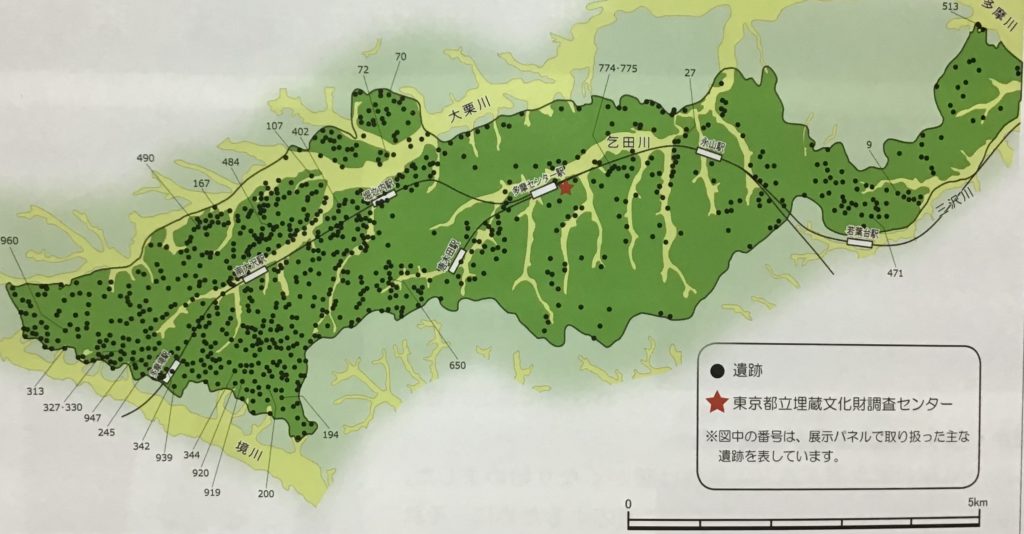

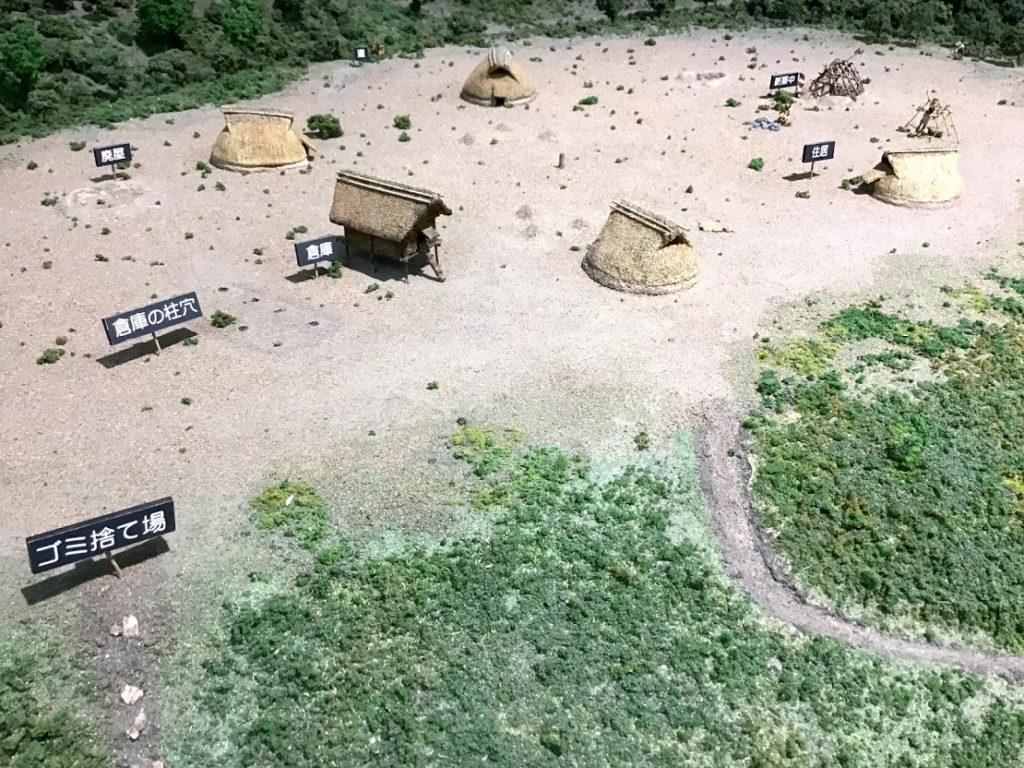
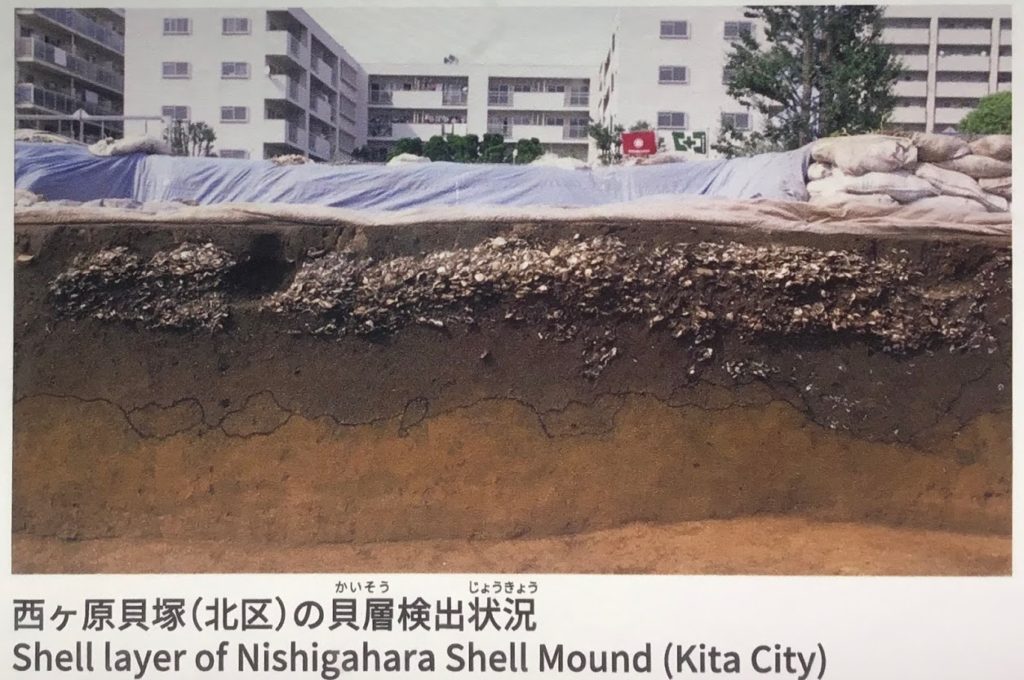



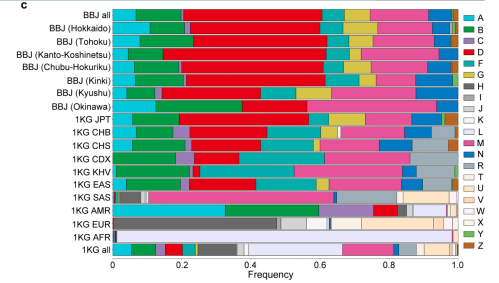
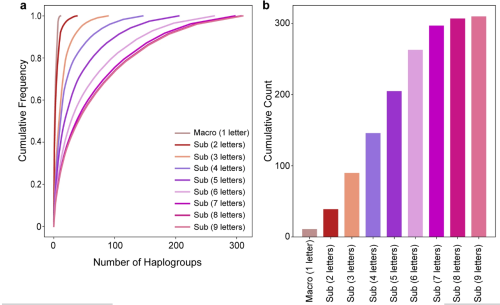


































































































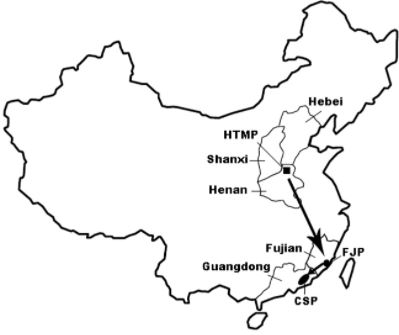









 5
5





 4.7 thousand years (ky). The age of STR variation of hg O in Southeast Asia probably exceeds 26 ky,
4.7 thousand years (ky). The age of STR variation of hg O in Southeast Asia probably exceeds 26 ky,







